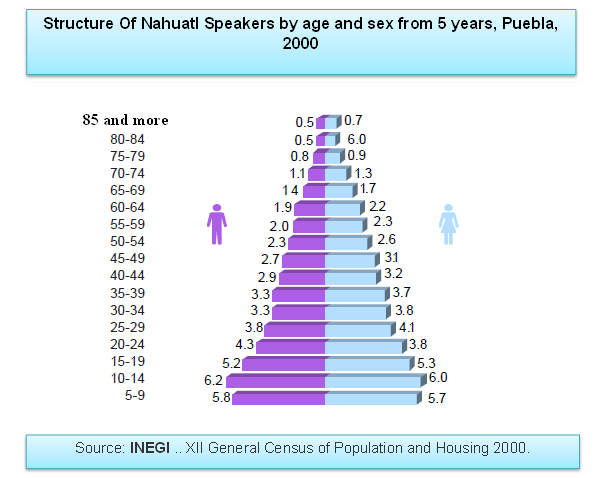
- •1 Introduction
- •Purpose of the Study
- •Research Questions.
- •Key Words
- •1.4 Significance of the study
- •2 Literature Review
- •2.1 Nahuatl
- •2.1.1 History Nahuatl civilization
- •2.1.2 Nahuatl grammar
- •Nahuatl in Puebla
- •Figure 2.2.2
- •2.2.1The Mixtec of Puebla
- •2.3 Education in Mexico
- •2.3.1 The history of the indigenous education in Mexico
- •2.4 Bilingual education at present
- •2.4.1 Benefits of bilingual education
- •2.5 Critical Pedagogy.
- •2.6 The role of the school and family in the bilingual education
- •2.6.1 Empowering Parents
- •2.6.2 How oral tradition can be used to teach academic skills
- •3. Methodology
- •3.1 Subjects
- •3.2 Instruments
- •3.3 Interviews
- •3.4 Activities
- •4. Findings
- •Answers of interview made to adults.
- •4.2 Answers of interview made to teenagers.
- •4.3 Answers of interview made to children.
- •4.4 Results of activities applied to children
- •5. Conclusions
- •5.1 General overview
- •5.2 Implications for further study.
- •5.3 Limitations of the study
- •5.4 Directions for further research
- •Appendix 1: Poster used to let people know about the conference.
- •Appendix 4: the questionaire administered to parents
- •Appendix 5: the questionaire administered to teenagers
- •Appendix 10: legend of the lagoon of xochiltepec in spanish
- •Appendix 11: legend of the lagoon of xochiltepec in nahuatl
Nahuatl in Puebla
Puebla is located in the central part of Mexico. In the north it borders with the state of Hidalgo, in the east, with the state of Veracruz, in the south with Oaxaca and Guerrero, and west by the states of Morelos, Mexico, Tlaxcala and Hidalgo. The climate is contrasting, and going from the cold of high mountains to the warm semi-desert of the Mixteca.
By the 7th AD century, in the valley of Puebla a complex of agricultural populations came which were integrated into a wide network of trade dominated by the Olmecs. Among these were Amalucan, Totimehuacan, Las Bocas and Cholula. The latter would eventually become the star of pre-Columbian history. During the classical period Cholula was an important ally of Teotihuacan, and its decline, Cholula enjoyed one of its best periods. Meanwhile, in the south, Acatlán became one of the most important centers of Ñuiñe culture, dedicated to the trade of cochineal and other products in the Mixteca. In the collapse of Teotihuacan, which occurred in the 8th century AD, the Valley of Puebla saw one of the most splendid periods of Cholula, the old city of Quetzalcoatl. However, this city, which became one of the largest in Mesoamerica was abandoned by most of its inhabitants. (Hernandez et al 2009)
In Puebla there are two major indigenous regions: the Sierra Norte and Sierra Negra. In the the sierra norte there are groups of Nahua, Totonac and Otomi, speakers which live in places like Cuetzalan del Progreso, Pahuatlán, Huehuetla and Teziutlán. The Sierra Negra is one of the main sources of migrant labor (INEGI, 2012) in the state of Puebla. The indigenous region of the Sierra Negra is strongly related to the city of Tehuacan, where Indians represent the 21% of the population. Other indigenous municipalities are isolated in the southwest and central of the state. In the south and east of the state we find important Mixtec and Nahua populations respectively.
About 15% of the population over five years old of the state speaks an indigenous language. Nahuatl speakers constitute the largest indigenous language communities in the state. They represent over 70% of the population and are concentrated in the regions of the Sierra Norte and Sierra Negra.
There are many Nahuatl speakers living in the whole country, however, According to INEGI 67.2% of Nahuatl speakers live in three states: Puebla, Veracruz and Hidalgo. 28.7% of the speakers live in Puebla (416,968 people),(See Table 1.) If we break down the population of Nahuatl speakers according to age, just over half are children and young people: those under 15 years make up 23.9% and 15 to 29 year-olds make up 28%. Adults between 30 and 59 years of age represent 35.9% of the population, and 12.2% were 60 years or older.
In Puebla, the Nahuatl-speaking population has a similar structure by age and sex to that recorded nationally. The population under 15 years of age represents 23.7%, while 27.5 % is for young people and from 30 to 59 years participate with 35.2%, while the Nahuatl speakers of 60 years and over are 13.6 percent. Women represent 52% of the population, with slightly higher rates than men in almost all age groups except the two youngest age groups (see Figure 2.2.2).

